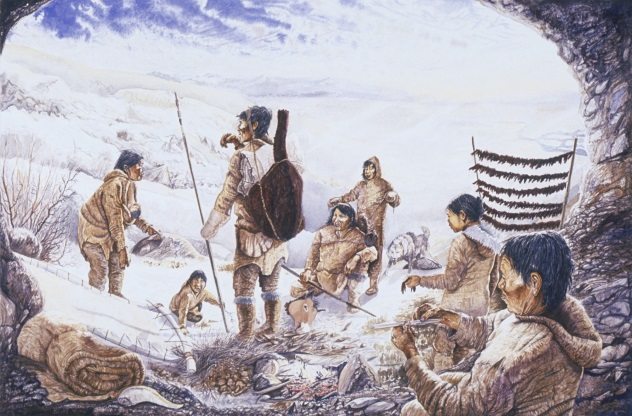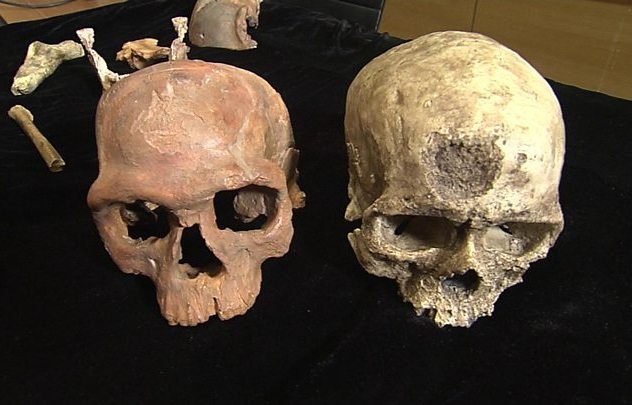 Mysteries
Mysteries  Mysteries
Mysteries  History
History 10 Surprising Stories About the Texas Rangers
 Humans
Humans 10 Philosophers Who Were Driven Mad by Their Own Theories
 Miscellaneous
Miscellaneous 10 Video-Game-Worthy Weapons and Armors from History
 Weird Stuff
Weird Stuff 10 Psychics Who Accurately Predicted Wartime Events
 The Arts
The Arts 10 Pieces of Art Inspired by a Broken Heart
 Health
Health 10 Science Fiction-Sounding New Medical Treatments
 History
History 10 Surprising Facts About the Father of Submarine Warfare
 Space
Space Ten Astonishing New Insights into Alien Worlds
 Weird Stuff
Weird Stuff 10 Bizarre Summer Solstice Rituals Still Practiced Today
 Mysteries
Mysteries Top 10 Haunting Facts About the Ghost Ship MV Alta
 History
History 10 Surprising Stories About the Texas Rangers
 Humans
Humans 10 Philosophers Who Were Driven Mad by Their Own Theories
Who's Behind Listverse?

Jamie Frater
Head Editor
Jamie founded Listverse due to an insatiable desire to share fascinating, obscure, and bizarre facts. He has been a guest speaker on numerous national radio and television stations and is a five time published author.
More About Us Miscellaneous
Miscellaneous 10 Video-Game-Worthy Weapons and Armors from History
 Weird Stuff
Weird Stuff 10 Psychics Who Accurately Predicted Wartime Events
 The Arts
The Arts 10 Pieces of Art Inspired by a Broken Heart
 Health
Health 10 Science Fiction-Sounding New Medical Treatments
 History
History 10 Surprising Facts About the Father of Submarine Warfare
 Space
Space Ten Astonishing New Insights into Alien Worlds
 Weird Stuff
Weird Stuff 10 Bizarre Summer Solstice Rituals Still Practiced Today
10 Historical Controversies With Recent Developments
Sometimes, it can be very difficult to distinguish historical fact from historical fiction. In some cases, the lack of solid evidence makes a definitive conclusion impossible, while in others, new findings keep changing the official story. Academic biases can also muddy the waters at times.
Many things in history are open to passionate debate. The following historical issues have all been hot-button topics at one point or another and have been debated for decades, even centuries. And all of them have had recent developments which added another twist to the tale.
10 Is The Warren Cup Real?

The Warren Cup is one of the most expensive items owned by the British Museum and is known for its graphic depiction of gay sex, including a scene between a man and a youth. Because of this, it was considered too obscene for a long time, and many museums refused to buy it. Today, however, many regard the Warren Cup as one of the most well-preserved examples of ancient Roman erotic art.
Due to its uniqueness, some experts have doubted the cup’s authenticity. They claim that the 2,000-year-old drinking vessel is actually a forgery from the late 19th or early 20th century. Most recently, Humboldt University Professor Luca Giuliani asserted that the iconography is unlike anything seen on Roman tableware but is reminiscent of early 1900s erotica.[1] He argued the cup was specifically made for its first modern owner, Edward Warren, a collector of erotic memorabilia who possessed other counterfeits in his collection.
9 Who Raised The Flag On Iwo Jima?

Raising the Flag on Iwo Jima is one of the most iconic photographs of all time. However, most people forget all the controversy surrounding the misidentification of the Marines in the photo, which still hasn’t been fully resolved.
Originally, the six soldiers were identified as Ira Hayes, Rene Gagnon, Henry Hansen, Michael Strank, John Bradley, and Franklin Sousley. President Roosevelt wanted to bring them back and use them in a bond drive to raise funds. Unfortunately, three of those men died days after the photograph was taken.
At the same time, word started to spread that the Marine identified as Henry Hansen was actually Harlan Block. Ira Hayes claimed this was true and that he was told to keep quiet, as the official identifications had already been released. It wasn’t until Block’s mother wrote her congressman that an inquiry was opened which rectified the misidentification.
Seven decades on, people still aren’t sure who was in the photograph. In 2016, a new Marine Corps investigation concluded that Harold Schultz was actually in the photo instead of John Bradley.[2] Members of the investigation panel believed Schultz was aware of the misidentification. It is unknown why he chose to remain silent, even though he survived the war and lived until 1995.
8 Have We Found Akhenaten’s Tomb?

Ancient Egypt still holds many mysteries to us. Currently, experts are debating whether or not we’ve solved one of those mysteries using modern technology: the identity of the KV55 mummy.
KV55 is a tomb in the Valley of the Kings discovered in 1907. The sarcophagus found inside had been desecrated, and its face mask was ripped off and inscriptions chiseled away. For over a century, Egyptologists have been debating the identity of the mummy. Other artifacts found in the tomb tentatively made scholars believe its inhabitant was the infamous pharaoh Akhenaten, father of Tutankhamun and religious heretic. However, examination of the skeleton placed the mummy’s age at 20 to 25 years. Many proclaimed this was too young to be Akhenaten and that the mummy was more likely his short-lived successor, Smenkhkare.
Other experts weren’t convinced, though, arguing that the methods used to establish a mummy’s age of death weren’t completely reliable. The skeleton also showed possible signs of Frolich’s syndrome, which could have stunted normal growth.
Modern tests presented in 2010 came out in favor of Akhenaten. CAT scans and DNA tests performed on a dozen royal mummies over several years showed that the KV55 mummy was the son of Amenhotep III and father of Tutankhamun.[3] According to inscriptions, that would be Akhenaten.
This only strengthened the controversy. Opponents have two issues with the findings: First, they believe that accurate DNA tests on mummies are impossible due to degradation and contamination. Secondly, they consider any records regarding Akhenaten unreliable, since the ancient Egyptians tried to erase him from history after his death.
7 Have We Identified Jack The Ripper?

There have been hundreds of books and countless theories about Jack the Ripper. Despite this, new developments still happen that spur on the debate regarding the identity of the notorious serial killer.
Back in 1992, Ripperologists were stunned when a man named Michael Barrett presented what he claimed was the diary of Jack the Ripper. Allegedly, it belonged to a wealthy cotton merchant from Liverpool named James Maybrick. He described the five canonical murders in detail (as well as a sixth one) and revealed that he was, indeed, Jack the Ripper.
Obviously, there were many skeptics who promptly dismissed the diary as a hoax. To make matters worse, Barrett was evasive about how he obtained the diary and changed his story several times. At one point, he even signed an affidavit saying he was the author, but he later retracted it.
Experts performed several tests on the diary, particularly on the ink to try and date it. While nothing was ever definitive, nothing was found that was inconsistent with 1888. There was also circumstantial evidence which strengthened Barrett’s case. Maybrick died in 1889, which could explain why the Ripper stopped killing. Also, some historians believed that Barrett was simply incapable of such a convincing forgery.
In 2017, a new team of experts declared the diary genuine.[4] It also contains details about the murders that should not have been known to anyone outside police and the killer. Many Ripper enthusiasts are now convinced that James Maybrick was Saucy Jack. Expect the debate to be hotly renewed within the months and years to come.
6 Did Ancient Humans Settle In Beringia?

New archaeological discoveries are constantly rewriting history, especially when it comes to the first human settlements. Not all new ideas are embraced with open arms, though, especially when they contradict long-held beliefs.
It has been accepted for decades that the Clovis people were the first to settle in the Americas roughly 13,000 years ago. There have been several new hypotheses that challenge that view, but one of them has actually been around for four decades.
In 1977, an archaeologist named Jacques Cinq-Mars began excavating the Bluefish Caves in Canada. They are located in a region called Beringia, which consists of the Bering Sea, Bering Strait, and landmasses from Russia, Canada, and Alaska. Thousands of years ago, Beringia was one land before being submerged by the ocean. Cinq-Mars claimed he found toolmarks on horse and mammoth bones, which were dated up to 24,000 years ago. Therefore, Cinq-Mars presented the Beringian standstill hypothesis—the idea that ancient humans made a 10,000-year stop in Beringia before settling in North America.
Cinq-Mars’s theory met heavy resistance from the scientific community, and even though he championed it for decades, it eventually faded away. However, in 2017, a team at the University of Montreal backed up his findings. Using modern technology, they examined 36,000 bone fragments recovered from Bluefish Caves and found 15 samples which featured cuts from stone tools. They ranged between 12,000 and 24,000 years old.[5] It remains to be seen if the theory will receive a warmer welcome today.
5 Why Were Women Buried At Stonehenge?

If you want mysterious ancient monuments that still puzzle experts even after decades of study, look no further than Stonehenge. It seems that every few years, archaeologists make a new discovery at the prehistoric landmark which changes our perception of it.
One of the most curious features of Stonehenge are the Aubrey Holes, a ring of 56 chalk pits surrounding the main structure. They have been excavated since the 1920s and have revealed cremated remains, showing that, at least in its early stages, Stonehenge functioned as a cemetery.
The excavations continued, and in 2016, archaeologists found the remains of 14 women in Aubrey Hole 7. Their ages ranged between 4,000 and 5,000 years old.[6] Experts agree that the women buried at Stonehenge had to have been of high status, but the find raises new questions regarding the overall role women had in the community that inhabited the area. Project member Christie Willis opined that women’s status within that society equaled that of men. Also curious was the lack of any children’s remains. Archaeologist Mike Pitts speculated that they had also been cremated, but their ashes were scattered instead of buried.
4 Who Was The Great Sphinx?

In 1817, Italian explorer and archaeologist Giovanni Battista Caviglia began the first modern excavation of the Great Sphinx on the Giza Plateau. Even though scholars have been studying the statue for 200 years, we still hardly know anything about it.
We have found no inscriptions from the Old Kingdom of Egypt relating to the statue. We call it the Sphinx, a name given thousands of years later by the Greeks, but we don’t know its real name, who built it, or why.
Most intriguing is the identity of the Sphinx. Mark Lehner is one of the leading experts on the statue. He’s been researching and excavating the Giza Plateau for over 30 years, including five years spent mapping out every inch of the Sphinx. He subscribes to the most prevalent theory that the statue was built by Khafre, who also built the second-largest pyramid at Giza. Lehner and other Egyptologists contend that evidence such as causeway ruins point to one massive building plan which included the Sphinx, Khafre’s pyramid, and several temples.[7] Lehner also believes the Sphinx, the adjacent temple, and the pyramid were arranged to link with solar events like the summer solstice.
Other scholars such as German Egyptologist Rainer Stadelmann believe the Sphinx represents the builder of the Great Pyramid himself, Pharaoh Khufu. Stadelmann argues that the facial features, iconography, and style are more reminiscent of Khufu and claims that the causeway was built to conform to a preexisting structure, the Sphinx.
Most recently, French archaeologist Vassil Dobrev claimed in 2004 that the Sphinx was built by Djedefre, an oft-forgotten pharaoh who ruled between Khufu and Khafre. He agrees with Stadelmann that the image depicts Khufu and that the causeway was built around an existing structure.
3 Is The Grolier Codex Real?

Back in 1971, members of the bibliophile society called the Grolier Club displayed a priceless historical artifact—a Mayan codex. These books about the pre-Columbian civilization are exceedingly rare, as most were destroyed by Catholics. So far, only three others have been found and authenticated, all in the 19th century.
Initially, most academics believed it to be a forgery. They argued that the codex had unusual iconography and that some of its pages looked cut recently and were only written on one side, unlike the other codices. They also weren’t convinced by the sketchy story of how collector Josue Saenz obtained the book from looters.
However, some professors have turned around in recent years. One test on the paper showed that it was genuine Mayan bark paper from the 13th century. This wasn’t enough to convince all skeptics, however, as blank paper was far more common than codices and could have been used by skilled forgers.
In 2016, a team at Brown University declared the Grolier Codex genuine, providing explanations for all the objections to the book’s authenticity. Not only that, but they asserted that the codex was a calendar tracking the movements of Venus and that it was made sometime around 1230. This would make it the oldest book in the Americas.[8] It remains to be seen if this new study will convince the academic community as a whole to accept the Grolier Codex as genuine.
2 Did We Find Nefertiti 100 Years Ago?

Queen Nefertiti is one of the most prominent and scandalous names to come out of ancient Egypt, and Egyptologists have been looking for her tomb for decades. However, one controversial hypothesis suggests that she’s been sitting in a museum since the late 19th century.
In 2003, archaeologist Joann Fletcher suggested that Nefertiti could be a mummy known as the Younger Lady, which was found in tomb KV35 in 1898. She reasoned that the mummy had a wig with a Nubian hairstyle and a double-pierced ear, which were attributed to Nefertiti and rare in her time. The idea caused a media frenzy but found little support from the academic community, which considered it plausible but lacking in any solid evidence.
The first development happened in 2010, when DNA testing performed on the Younger Lady revealed her to be Tutankhamun’s mother and wife and sister to Amenhotep IV, aka Akhenaten. Nefertiti was the great royal wife and cousin to Akhenaten.
The idea resurged in 2013 thanks to French Egyptologist Marc Gabolde, who believed the original DNA results were misinterpreted. Initially, the genetic closeness between the Younger Lady and Tutankhamun was attributed to brother-to-sister mating. However, Gabolde claimed the same result could be obtained through three successive generations of marriage between first cousins.[9] That would mean that the Younger Lady is Nefertiti and mother to Tutankhamun. Others contend that the mummy is an unnamed daughter of Amenhotep III and Queen Tiye.
1 When Did Homo Sapiens Appear?

Piecing together the various stages of human evolution has proven to be one of the most ambitious scientific endeavors in history. New pieces of evidence are constantly being found which challenge our beliefs. In 2017, we found something that might force us to rewrite human history entirely: 315,000-year-old fossils of Homo sapiens.[10] They are notable for two reasons: They are 100,000 years older than the previous oldest fossils, and they didn’t come from Sub-Saharan Africa.
The discovery was made at an archaeological site named Jebel Irhoud in Morocco following a ten-year dig. A team led by paleoanthropologist Jean-Jacques Hublin found skulls, jawbones, and tools, which were initially thought to be Neanderthal and no more than 40,000 years old. However, the surrounding fauna seemed to be much older. Subsequent thermoluminescence dating tests placed the age of the tools at 315,000 years, and radiocarbon dating showed the bones to be between 280,000 and 350,000 years old.
Not everyone is convinced the remains come from Homo sapiens. Paleoanthropologist Maria Martinon-Torres points to the lack of the prominent chins and foreheads characteristic of our species. It’s still too early to tell what kind of impact the find will have on our evolutionary history. Hublin believes that early humans formed a large, interbreeding population which dispersed all over Africa instead of being confined to one region. Others have suggested the fossils belonged to an archaic species of humans which survived until Homo sapiens came from the south and replaced them.
For more historical points of contention, check out 10 Controversial Alternative Views Of Historical Events and 10 Controversial Artifacts That Could Have Changed History.








